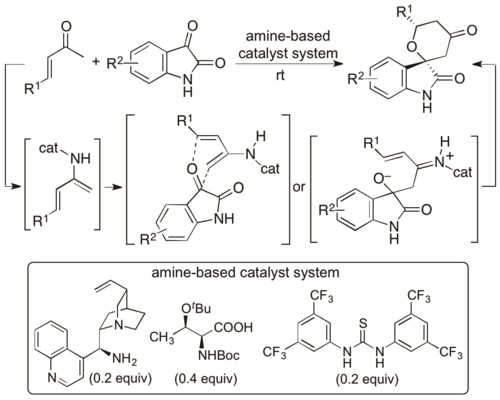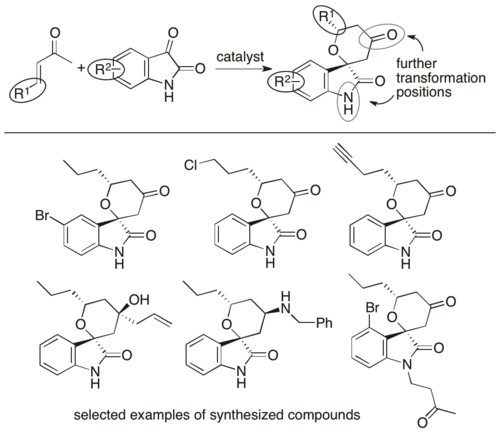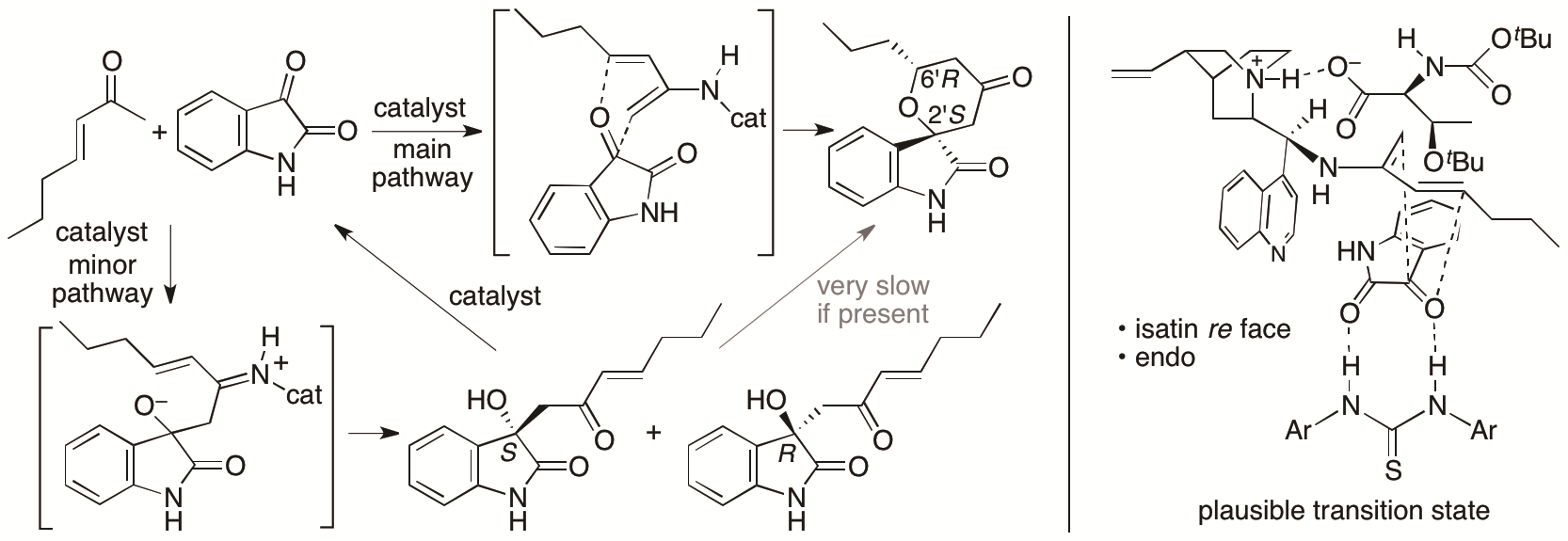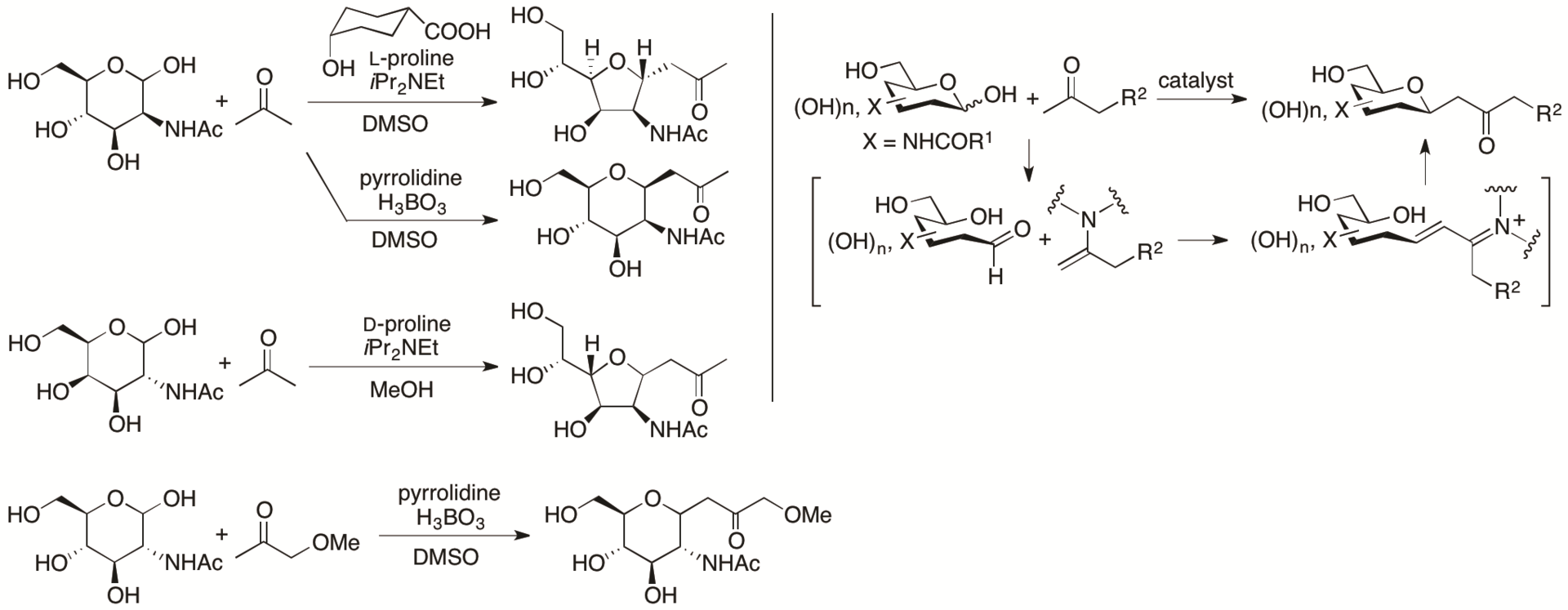FY2015 Annual Report
Chemistry and Chemical Bioengineering Unit
Professor Dr. Fujie Tanaka, Associate Professor
Abstract
The ability to design and synthesize organic molecules constitutes the foundation of that underlies basic research as well as applied science. It is also essential for the development of pharmaceuticals and biofunctional molecules. This unit develops new, efficient, concise, and safe chemical transformation methods and strategies for constructing small molecules bearing functional groups and/or chiral centers that are relevant to the creation of biofunctional molecules. We design and create small organic molecule catalyst systems to enable to perform designed chemical transformations and develop reaction strategies that use small organic molecules as enzyme-like catalysts. With the use of organic molecules as catalysts, we minimize the need for protection and deprotection steps that are usually required for the synthesis of functionalized molecules. When a reaction method does not affect functional groups that are not at the reaction site, the reaction method can be used for the synthesis of a series of molecules bearing various functional groups. That is, a series of molecules of interest may be synthesized using the same method in a short route, providing advantages for the synthesis of biofunctional candidate molecules. We also investigate the chemical bases of the reactions to understand the mechanisms of the catalysis and molecular interactions provided by organic molecules. By taking advantage of the use of features of our developing molecules, we also develop strategies and methods to conjugate proteins and peptides with other molecules. The molecules that we have synthesized are screened in various functional assays in collaboration with other research groups. The research undertaken by this unit advances the chemistry of catalysis and of molecular synthesis. The studies by this unit accelerate the creation of molecules used in biomedical research and contribute to the development of new therapeutics, therapeutic strategies, and diagnostics.
1. Staff
- Dr. Pandurang V. Chouthaiwale
- Dr. Jithender Enukonda
- Dr. Ji-Rong Huang
- Dr. Sherida Johnson
- Dr. Lingaiah Maram
- Dr. Muhammad Sohail
- Dr. Krishna Yarkali
- Dr. Feng Yin
- Swetha Enukonda
- Maria Rosa Mendoza Quijano
- Dongxin Zhang, Graduate Student
- Po-Shun Chuang, Graduate Student (Rotation)
- Sebastien Lapointe, Graduate Student (Rotation)
- Hiroki Saito, Research Intern
- Ms. Shiho Chinen, Research Unit Administrator
2. Activities and Findings
2.1. Development of new chemical transformation methods and synthesis of functionalized molecules
We have been developing small organic molecule catalysts (organocatalysts) and organocatalytic molecular transformation methods useful for the synthesis of functionalized molecules under mild conditions in short routes. We also investigate the chemical basis of the catalysis and the chemical transformations to understand the mechanisms of the catalysis and molecular interactions provided by organic molecules to further the creation of useful molecules.
Traditional synthetic methods often require high or very low temperature and/or absolute conditions. In addition, functional groups on substrate molecules must be protected prior reactions. That is, depending on functional groups present in target molecules to be synthesized, synthetic routes, including protection and deprotection steps, have to be designed for each molecule. To concisely synthesize functionalized molecules, chemical transformation methods that are not affected by functional groups presenting in starting materials are needed. It is a great advantage when the same reaction method can be used for the synthesis of a series of molecules bearing various functional groups without the need of product-specific protection and deprotection steps. In addition, it is desired that such reactions can be performed under safe, mild, and environmentally benign conditions. We address these points in our research as we design and develop catalysts and chemical transformation methods. By using organic molecules as catalysts, we concisely synthesize novel functionalized molecules including those that are often difficult to synthesize by traditional synthetic strategies. Our studies provide molecules that are screened for bioactive candidates and contribute to the creation of new functional molecules.Our investigation on the chemical basis of the developed catalysts and chemical transformation methods further the understanding of the chemistry of organic molecules and their reactions.
2.1.1. Asymmetric oxa-hetero-Diels-Alder reactions: Synthesis of spirooxindole tetrahydropyran derivatives
One of the recent achievements of this unit is the development of catalytic asymmetric hetero-Diels-Alder reactions of enones with isatins (2,3-dioxyindoles or 2,3-dioxyindolins) that provide functionalized spirooxindole tetrahydropyranones with high diastereo- and enantioselectivities (Scheme 1) (Cui & Tanaka, Chem. Eur. J. 2013, 19, 6213). Novel amine-based catalyst systems composed of three-types of molecules (amine, acid, and thiourea) have been developed to catalyze the reactions. Various spirooxindole tetrahydropyranones were synthesized by this developed reaction method.

Scheme 1
The products of the reactions retain the ketone and amide groups. With transformations at these reaction sites, various spirooxindole tetrahydropyran derivatives were also synthesized (Cui, Chouthaiwale, Yin, & Tanaka, Org. Biomol. Chem. 2016, 14, 259). As both the spirooxindole derivatives and the tetrahydropyranes are found in many bioactive molecules, our synthesized molecules are of interest. In our reaction system, selections of the R1 and R2 groups of the starting materials enones and isatins to form the oxa-hetero-Diels-Alder reaction products and further transformations of the products at the ketone and amide groups allow concise, atom-economical access to various spirooxindole tetrahydropyran derivatives bearing functional groups in four directions in a three-dimensional space (Scheme 2). This structural feature would be useful in the search for new functional molecules. In fact, synthesized spirooxindole tetrahydropyrans were screened in bioasay systems and an inhibitor of human ion channel Nav1.7 with µM-level activity was identified (see also Section 2.4).

Scheme 2
We investigated the mechanism of the reactions and key factors for the high diastero- and enantioselectivities achieved by the three-component catalyst system (Cui, Chouthaiwale, Yin & Tanaka, Asian J. Org. Chem. 2016, 5, 153). Our reaction-based investigation indicated that the products were formed via a kinetically controlled [4+2] cycloaddition of the in situ-generated enamine of the enone as the diene and isatin as the dienophile (Scheme 3). In the transition state of the [4 + 2] step, the acid component of the catalyst system likely interacts with the tertiary amine and contributes to the stereocontrol.

Scheme 3
The design and synthesis of catalysts that function as one molecule by providing all the required interactions for the catalysis and stereocontrol of designed reactions especially for new reactions are often difficult. We have demonstrated that the use of multicomponent catalyst systems provides a way to bypass the limitations in accessing to single component catalysts.
2.1.2. Asymmetric oxa-hetero-Diels-Alder reactions: Synthesis of tetrahydropyran derivatives bearing trifluoromethyl-substituted tetrasubstituted carbon centers
Based on the success of the development of the oxa-hetero-Diels-Alder reactions of enones with isatins (Section 2.1.1.), we have been expanding the reactions beyond the use of the oxindole dienophiles to the use of various ketones and aldehydes as dienophiles. We have developed catalytic asymmetric oxa-hetero-Diels-Alder reactions of enones with aryl trifluoromethyl ketones to synthesize tetrahydropyrans bearing a trifluoromethyl group (Scheme 4) (Zhang & Tanaka, RSC Adv. 2016, 6, 61454). Incorporation of the trifluoromethyl group has been shown to favour bioactivity; concise routes to highly-enantiomerically enriched tetrahydropyrans bearing a trifluoromethyl group are of interest. Using our method, trifluoromethyl group-substituted terasubstituted carbon centers, which are usually difficult to access, were readily constructed with the formation of the tetrahydropyranone ring.

Scheme 4
The catalyst systems useful for the reactions of enones with aryl trifluoromethyl ketones to afford tetrahydropyranones as the products differed from those developed for the reactions of enones with aryl trifluoromethyl ketones. Whereas the developed amine-based catalyst systems catalyzed the oxa-hetero-Diels-Alder reactions described above, many amine-based catalysts and other types of catalysts accelerate the reactions of enones to give aldol products, not the hetero-Diels-Alder reaction products. We are continuing the study to elucidate the molecular mechanisms of the catalysis and factors to enable to control the reactions to afford predefined designed products with high chemo- and stereoselectivities.
2.1.3. DBU-catalyzed aldol reactions
We have recently developed concise, fast DBU-catalyzed aldol reactions of a pyruvic aldehyde derivative 1,1-dimethoxypropan-2-one with isatins (Zhang, Johnson, Cui & Tanaka, Asian J. Org. Chem. 2014, 3, 391). We have expanded the DBU-catalysis to aldol reactions of aryl trifluoromethyl ketones with various donor substrates to give trifluoromethyl-substituted tertiary alcohols (Zhang & Tanaka, Adv. Synth. Catal. 2015, 357, 3458). In these DBU-catalyzed aldol reactions, the C-C bonds formed in perfect regioselectivities at the methyl groups of alkyl methyl ketones, at the γ-positions of β-keto esters, and at the methyl groups of the β-methyl-substituted cyclic enones (Scheme 5). For the aldol products from the β-keto esters, enantiomerically pure forms were obtained by the resolution of the enamines of the aldol products with a homochiral amine. With DBU as the catalyst, construction of tetra-substituted alcohols bearing the trifluoromethyl group, which is difficult and/or usually requires severe conditions to synthesize, was concisely achieved under mild conditions. In addition, concise resolution method was established to provide access to pure enantiomers of the products from the reactions of β-keto esters. We are also designing and synthesizing DBU-inspired chiral versions of catalysts to perform enantioselective aldol reactions and related reactions.

Scheme 5
2.1.4. Cascade reactions of pyruvates with aldehydes to synthesize various functionalized molecules
Pyruvates can act as nucleophiles and electrophiles and thus are expected useful synthons. However, the dual reactivities of pyruvates are difficult to control. We have recently developed concise cascade reactions of pyruvates to provide various functionalized dihydropyrans in one pot under mild conditions (Scheme 6) (Chouthaiwale & Tanaka, Chem. Commun. 2014, 50, 14881). Further, we have demonstrated that the product dihydropyrans are readily transformed to various molecules including amino group-substituted and fluoro group-substituted ddihydropyrans, cyclohexane-derived amino acids, dihydrodiazepines, and pyridines.

Scheme 6
To further simplify the synthesis, we developed a one-pot method; 4-substituted-pyridine-2,6-dicarboxylic acid derivatives were synthesized in one pot from pyruvates and aldehydes (Chouthaiwale, Lapointe, & Tanaka, Heterocycles, in press).
2.1.5. Direct C-C bond-forming reactions of unprotected carbohydrates
Carbohydrate backbone-elongation reactions at anomeric carbons are important for the synthesis of higher carbon-backbone carbohydrates and C-glycosides. Generally, reactions on carbohydrates require protection of hydroxy groups that are later deprotected. If unprotected carbohydrates could be used as substrates, the methods would be atom- and step-economical. There are only limited numbers of non-enzymatic direct C-C bond forming reactions at the anomeric carbon of unprotected aldoses that are mainly present as cyclic hemiacetals. We developed direct C-glycoside formation reactions of unprotected 2-N-acetyl-aldohexoses via aldol condensation-oxa-Michael reactions catalyzed by amine-based catalysts (Scheme 7) (Johnson & Tanaka, Org. Biomol. Chem. 2016, 14, 259).

Scheme 7
We are continuing to develop carbohydrate backbone-elongation reactions of unprotected carbohydrates, including the reactions of unprotected oligosaccharides.
2.2. Fluorescence-based reaction monitoring systems
This unit has also been developing concise fluorescence-based assay methods to monitor bond-forming and bond-breaking reaction progress on a small scale to facilitate the development of catalysts and catalyzed chemical transformation methods. Use of fluorogenic substrates provides a straightforward method of reaction monitoring because reaction progress is directly observed as an increase in fluorescence.
For example, we have developed fluorogenic aldehydes based on a diarylacetylene core structure and fluorescence-based assay systems for aldol reactions using the fluorogenic aldehydes (Scheme 8) (Katsuyama, Chouthaiwale, Akama, Cui & Tanaka, Tetrahedron Lett. 2014, 55, 74). We are continuing to develop fluorogenic substrates and fluorescence-based assay systems with improved features.

Scheme 8
2.3. Development of bioconjugation systems
Protein labeling methods are required for the synthesis of antibody-drug conjugates and other protein conjugates; these molecules are important as therapeutics and as detection devices for molecules of interest. Conjugation reactions are also needed to create multifunctional molecules. We are developing efficient protein labeling systems and molecules with desired reactivities that can be used for protein labeling reactions at targeted sites.
2.4. Search of biofunctional molecules
As described above, we have synthesized various functionalized molecules. In collaboration with researchers whose expertise is in biology and screening for biofunctional molecules, we have been searching new biofunctional molecules and drug leads. The collaborations include:
- Professor Hiroshi Tomoda, Kitasato University
- Screening Committee of Anticancer Drugs supported by Grant-in-Aid for Scientific Research on Innovative Areas, Scientific Support Programs for Cancer Research, from The Ministry of Education, Culture, Sports, Science and Technology, Japan
- Okinawa Intellectual Cluster Program “Exploration Research on The Development of Pharmaceuticals and Their Candidates Using Bioresources and Networks in Okinawa”
3. Publications
3.1. Journals
- Zhang, D., Tanaka, F. Aldol reactions of ketone donors with aryl trifluoromethyl ketone acceptors catalyzed by 1,8-diazabicyclo[5.4.0]undec-7-ene (DBU) for concise access to aryl- and trifluoromethyl-substituted tertiary alcohols. Advanced Synthesis & Catalysis, 357, 3458-3462 (2015), doi: 10.1002/adsc.201500497.
- Cui, H.-L., Chouthaiwale, P. V., Yin, F., Tanaka, F. Reaction-based mechanistic investigations of asymmetric hetero-Diels-Alder reactions of enones with isatins catalyzed by amine-based three-component catalyst systems. Asian Journal of Organic Chemistry, 5, 153-161 (2016), doi: 10.1002/ajoc.201500412.
- Johnson, S., Tanaka, F. Direct synthesis of C-glycosides from unprotected 2-N-acyl-aldohexoses via aldol condensation-oxa-Michael reactions with unactivated ketones. Organic & Biomolecular Chemistry, 14, 259-264 (2016), doi: 10.1039/c5ob02094h.
- Cui, H.-L., Chouthaiwale, P. V., Yin, F., Tanaka, F. Catalytic asymmetric hetero-Diels-Alder reactions of enones with isatins to access functionalized spirooxindole tetrahydropyrans: Scope, derivatization, and discovery of bioactives. Organic & Biomolecular Chemistry, 14, 1777-1783 (2016), doi: 10.1039/c5ob02393a.
- Zhang, D., Tanaka, F. Catalytic enantioselective oxa-hetero-Diels-Alder reactions of enones with aryl trifluoromethyl ketones. RSC Advances, 6, 61454-61457 (2016), doi: 10.1039/c6ra13859d.
- Chouthaiwale, P. V., Lapointe, S., Tanaka, F. Synthesis of 4-substituted-pyridine-2,6-dicarboxylic acid derivatives from pyruvates and aldehydes in one pot. Heterocycles, in press.
3.2. Oral and Poster Presentations
- Johnson, S., Tanaka, F. Stereoselective synthesis of C-glycosides from unprotected C6 aldopyranoses via amine-catalyzed aldol condensation-oxa-Michael addition reactions, The 8th Symposium on Organocatalysis and 5th Advanced Molecular Transformations by Organocatalysts Symposium, Naha, Japan (2015), 2015.05.10-2015.05.11.
- Tanaka, F. Molecular synthesis for the creation of new bioactive molecules, The 43rd Japan Ulcer Society Meeting, Onna, Okinawa, Japan (2015), 2015.06.19-2015.06.20.
- Tanaka, F. Synthesis of sugar derivatives for screening of bioactive molecules, The 1st Committee Meeting (H27), Okinawa Intellectual Cluster Program “Exploration Research on The Development of Pharmaceuticals and Their Candidates Using Bioresources and Networks in Okinawa”, Naha, Okinawa, Japan (2015), 2015.06.24.
- Zhang, D., Tanaka, F. DBU-catalyzed regioselective aldol reactions to synthesize functionalized molecules with tetrasubstituted carbon centers, The 38th Naito Conference The Chemistry of Organocatalysts, Sapporo, Japan (2015), 2015.07.06-2015.07.09
- Tanaka, F. Synthesis of sugar derivatives for screening of bioactive molecules, The 1st PI Meeting (H27), Okinawa Intellectual Cluster Program “Exploration Research on The Development of Pharmaceuticals and Their Candidates Using Bioresources and Networks in Okinawa”, Naha, Okinawa, Japan (2015), 2015.09.15. (Oral)
- Tanaka, F. Chemical synthesis toward the creation of new bioactives, in Symposium, Okinawa Intellectual Cluster Program, Naha, Okinawa, Japan (2015), 2015.12.17.
- Tanaka, F. Synthesis of sugar derivatives for screening of bioactive molecules, The 2nd Committee Meeting (H27), Okinawa Intellectual Cluster Program “Exploration Research on The Development of Pharmaceuticals and Their Candidates Using Bioresources and Networks in Okinawa”, Naha, Okinawa, Japan (2016), 2016.01.05.
- Tanaka, F. Development of efficient amine-based catalyst systems, The 6th Advanced Molecular Transformations by Organocatalysts Symposium, Osaka, Japan (2016), 2016.01.22-2016.01.23.
- Tanaka, F. Synthesis of molecules for the creation of biofunctional molecules, OIST-Kyushu University Women Scientists Networking Workshop, Okinawa, 2016.03.09.
- Zhang, D., Tanaka, F. Construction of aryl- and trifluoromethyl-substituted tertiary alcohols via aldol reactions catalyzed by 1,8-diazabicyclo[5.4.0]undec-7-ene (DBU), ISACS19: Challenges in Organic Chemistry, Irvine, USA, 2016.03.20-2016.03.23.
- Yin, F., Tanaka, F. Synthesis of 3-pyrrolidinecarboxylic acids via enantioselective organocatalytic Michael addition of nitroalkanes to 4-oxopent-2-enoate derivatives, The 136th Annual Meeting of the Pharmaceutical Society of Japan, Yokohama, Japan (2016), 2016.03.26-2016.03.29.
- Sohail, M., Zhang, D., Tanaka, F. Synthesis and application of analogs of 1,8-siazabicyclo[5.4.0]undec-7-ene (DBU), The 136th Annual Meeting of the Pharmaceutical Society of Japan, Yokohama, Japan (2016), 2016.03.26-2016.03.29.
- Zhang, D. & Tanaka, F. Catalytic enantioselective hetero-Diels-Alder reactions of enones with aryl trifluoromethyl ketones to give trifluoromethyl-substituted tetrahydropyranones, in Molecular Chirality Asia 2016, Osaka, Japan, 2016.04.20-2016.04.22.
- Maram, L.; Tanaka, F. Synthesis of iminosugar C-glycosides via a Mannich reaction-aminocyclization route, in Molecular Chirality Asia 2016, Osaka, Japan, 2016.04.20-2016.04.22.
4. Intellectual Property Rights
- Chouthaiwale, P. V., Tanaka, F. 4-Substituted pyridine-2,6-dicarboxylic acid derivatives and method of preparing same. Patent application, PCT/JP2015/004588 (filing date 2015.09.09).
- Tanaka, F., Zhang, D. 5-Substituted-5-hydroxy-5-aryl-3-oxo-pentanoate derivatives and their enantiopure forms. Patent application, PCT/JP2016/000507 (filing date 2016.02.01).
- Tanaka, F., Johnson, S. C-Glycoside derivatives. Patent application, PCT/JP2016/000506 (filing date 2016.02.01).
- Cui, H.-L., Tanaka, F. Spirooxindole derivative and process for producing the same, United States Patent 9,309,261 (patented date 2016.04.12, Document Identifier US 20150246927 A1, PCT publication No. WO2014058035 A1).
5. External Funding
- Tanaka, F. (PI) Development of efficient amine-based catalyst systems, Grant-in-Aid for Scientific Research on Innovative Areas “Advanced Molecular Transformations by Organocatalysts” from The Ministry of Education, Culture, Sports, Science and Technology (MEXT); Japan Society for the Promotion of Science (JSPS), Japan, April 2015 – March 2016.
- Tanaka, F. (PI) Synthesis of sugar derivatives for screening of bioactive molecules, Okinawa Intellectual Cluster Program “Exploration Research on The Development of Pharmaceuticals and Their Candidates Using Bioresources and Networks in Okinawa”, Okinawa, Japan, April 2015 – February 2016.
6. Other Activities
6.1. OIST Internal Seminars
- Date: May 20, 2016
- Venue: OIST Campus Lab3
- Speaker: Zhang, D.
- Title: Synthesis of molecules with tetrasubstituted crbon centers via functionalization of carbonyl compounds
6.2. Outreach Activities
- Date: February 18, 2016
- Venue: OIST Campus Lab2
- Speaker: Tanaka, F.
- Research introduction to students from University of the Ryukyus



